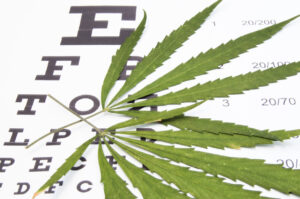25 years ago a few patients asked if their marijuana use was preventative for glaucoma. In 1996, marijuana was legalized in California for medical use. While few people asked me for prescriptions as there were plenty of other sources to get a “medical card,” I still had plenty of conversations about the use of marijuana not being a therapy for glaucoma. Marijuana is a poor option to treat glaucoma and it will not protect you from developing glaucoma.
Jump to 2018, Marijuana is now legal for recreational use in California for those over 21 years of age. Marijuana is still not a viable treatment for glaucoma.
So what is Glaucoma?
Glaucoma is atrophy of the optic nerve which causes the permanent loss of vision. One of the causes of optic nerve atrophy or destruction of the nerve fibers is increased pressure inside the eye (intra-ocular pressure or IOP). The THC in marijuana does lower the intra-ocular pressure. The IOP reduction peaks at 30 to 60 minutes and the effect lessens over 3-4 hours. To successfully treat glaucoma, IOP needs to be maintained at a lower amount for 24 hours everyday. That would require a lot of marijuana consumption. Fortunately, there are eye drops and surgical procedures that can usually achieve that goal with more accuracy, consistency and less side effects.
What about Red “Stoned” Eyes?
The most obvious effect marijuana has on the eyes is the redness generated from smoking or ingesting marijuana. The THC in marijuana triggers the smooth muscles in the blood vessels to expand causing vasodilation. The blood flow through the blood vessels increases which contributes to many of the effects one experiences from marijuana. In the eyes it makes the blood vessels on the surface dilate and look redder. Selecting a strain with more CBD and less THC will lessen the redness, but also reduce the “high.”
And Dry Eyes?
THC crosses the blood brain barrier and is a vasorelaxant causing a decrease in blood pressure, intraocular pressure and visual processing. It also causes decrease in tear production and reduces the blink rate making the eyes feel dry. This vasodilation also effects the salivary glands causing a dry mouth.
Any Health Benefits?
The 2 most abundant components of the cannabinoid are CBD, which is non-psychotic and THC which is psychotic.
Studies show that CBD has antioxidant and neuroprotective properties. It can be helpful in relieving inflammation, pain and other symptoms.
Marijuana has both adverse health effects and beneficial therapeutic effects. The FDA has approved a CBD-based liquid medication for the treatment of 2 forms of childhood epilepsy. Two THC based medications have also been approved by the FDA. One drug stimulates appetite for wasting syndrome due to AIDS and the other reduces nausea for patients undergoing cancer chemotherapy.
According to the National Institute of Drug Abuse, a branch of the National Institute of Health, development of drugs from botanicals such as marijuana prove challenging due to the unknown active chemicals. Use of marijuana as medicine poses problems due to the adverse health effects and the THC induced cognitive impairment.
